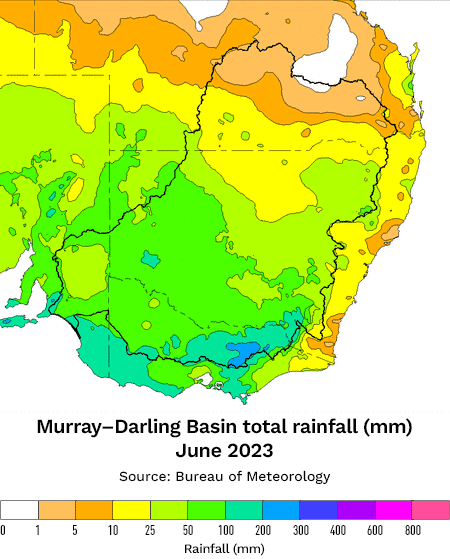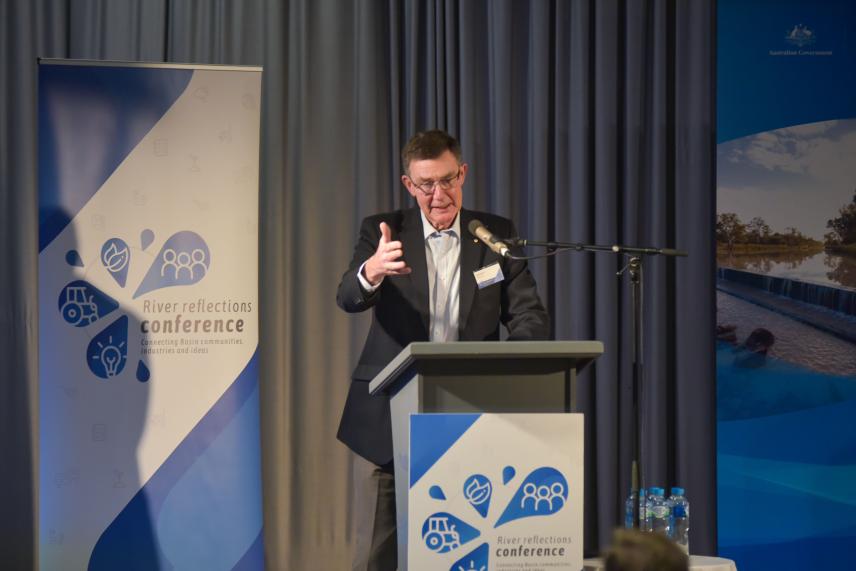- Mixed rainfall conditions across the Basin
- The Bureau continues to forecast drying conditions through winter into spring
- Spotlight: A wrap up of the 2023 River reflections conference

Drought
Conditions were mixed across the Basin in June, with a significant disparity in rainfall between the south west and north east.
North eastern catchments including the Condamine, Moonie and Gwydir recorded below average to very much below average rainfall. In the north west, low streamflows were observed.
In stark contrast, western and southern Basin catchments experienced a large band of very much above average rainfall, defying the predicted trend towards a dry winter and increasing chance of El Niño.
Increased rainfall did not translate to improved soil moisture conditions (one of the key factors of drought), with some areas of the Basin below average – particularly in Queensland.

Rainfall
Rainfall patterns for June reflect the deciles above, with little to no rain in the north, and up to 300 mm falling over the eastern Victorian ranges.
Highest rainfall across the month was recorded south of Benalla in the Ovens Catchment, which received over 370 mm. Surrounding areas stretching east and north also experienced high falls of around 200 mm.
Areas of the Lower Darling also saw significant rain, with many weather stations across the area recording more than 60 mm, and some in excess of 100 mm.

Water storages and streamflow
Cold conditions, low demand and moderate water releases have kept Storage levels across the Murray–Darling Basin around the same as previous months.
At 5 July total storage in the Basin was 20,877 GL (94%), which is an increase of 746 GL since late May. Southern Basin storages increased by 5% to 94% of capacity, while Northern Basin and Lachlan total storage remained constant over the same period.
Rainfall in the southern Basin created streamflow responses in Murray tributaries, Unregulated flows in the Murray River itself stretched from downstream of Hume Dam to the South Australian border.
Airspace management releases continued at Hume Dam to help mitigate flood risk over winter, into spring. Releases increased to 20,000 ML/d late in the month, and may increase further in response to rainfall.
Water regulators through the Barmah–Millewa Forest were open to accommodate higher upstream flows.
On the Darling, river operations were adjusted by WaterNSW in response to low dissolved oxygen at Mendindee Lakes. Flows downstream were around 950 ML/d, gradually receding into early July.
At the Lower Lakes, the barrages continued to pass unregulated flows into the Coorong and Southern Ocean.
Climate outlook
The Bureau’s forecast for the next few months continues to suggest drier and warmer conditions across most of Australia, including areas of the Basin – particularly Victoria and South Australia.
A 60% to 80% chance of below median rainfall is likely for most of Australia, with above median maximum temperatures very likely (greater than 80% chance).
The forecast is based on a likely El Niño development, the potential development of a positive Indian Ocean Dipole, and record warm oceans globally.

Water quality
The likelihood of water quality issues is low through winter, although there are exceptions. Basin rivers and storages are nutrient rich and conditions remain favourable for blue-green algae outbreaks. In the Lower Darling (Baaka) there is still a risk of low dissolved oxygen levels.
The Murray–Darling Basin Authority and state authorities monitor water quality conditions across the Basin year-round. For more information on water quality see the water quality page.
Summary of key water quality issues
- Hypoxic blackwater: Hypoxic blackwater is no longer a significant risk in most systems as floodwaters have receded.
- Low dissolved oxygen: In the Lower Darling (Baaka), dissolved oxygen levels generally remain near or above critical ecological thresholds.
- Blue-green algae: There is currently a risk of blue-green algae across most parts of the Murray–Darling Basin, particularly in New South Wales. For the latest information on blue-green algae alerts, contact your relevant state government agency.

Spotlight – A wrap up of the 2023 River reflections conference
River reflections is the Murray–Darling Basin’s annual regional water conference that connects and informs Basin communities, groups, industries, and governments.
This forum brings people together and provides space and time for the diverse communities of the Murray–Darling Basin to share knowledge, innovations, perspectives and achievements in water management.
The 2023 program included tours, presentations, panel discussions and breakout sessions and a dinner. 170 people attended in person and over 350 watched the live stream online each day.
During the conference, the roadmap to the 2026 Basin Plan Review was launched by Sir Angus Houston. The roadmap explains how we are preparing to review the Basin Plan in 2026.
30 speakers from across the Basin contributed a range of presentations over the 2-day event. Attendees also listened and learned from each other, as ideas were shared, and perspectives were heard.
A live stream was recorded and is available to watch below. Since the conference on 14 and 15 June, it’s been watched a further 1,500 times. More live stream recordings are available from day 2 of the conference.
Information about the 2024 conference will be announced soon.
Subscribe to our monthly newsletter River Reach, to keep informed.